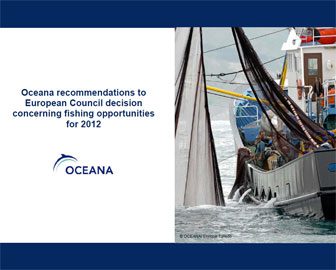Report | December, 2011
Oceana recommendations to European Council decision concerning fishing opportunities for 2012
State of resources
As concluded in the Communication from the Commission concerning Fishing Opportunities, fish stocks in European waters are improving. This is confirmed by the downward trend in the number of overfished and collapsed stocks. But the progress achieved in European fisheries management in relation to the fishing opportunities is clearly insufficient and Oceana is concerned about the state of resources.
The current situation, as described by the Commission, is that 63% and 82% of the managed stocks in the Atlantic and Mediterranean respectively are overfished. These figures are unacceptable. Clear actions and policies are obviously needed to phase out overfishing and guarantee the sustainable exploitation of resources.
Council Regulation fixing the fishing opportunities is one available tool to move towards more sustainable fisheries and to fix catch levels based on the principles and commitments of the Common Fisheries Policy.
Management plans’ successes and mistakes
Oceana supports the concept of long term management plans (LTMP) for stocks in European Waters, and calls on the European administrations to increase the number of stocks managed in this way.
However, it is worth highlighting that while some of these plans are working properly (Haddock in North Sea and Skagerrak, Northern Hake Stock, or Plaice in North Sea), others go against the precautionary approach (Cod in Irish Sea) or are inadequately implemented (Cod in Kattegat, West of Scotland, North Sea, Eastern Channel, and Skagerrak; Haddock in West of Scotland; or Nephrops and Hake in South Bay of Biscay).
Oceana suggests that management plans are reviewed and adapted based on the current management objectives of fishing opportunities, using the maximum sustainable yield (MSY) reference point (like multi-annual plan for the stock of herring distributed to the West of Scotland). If implemented, this process should also include integrated steps towards reaching a good environment status, such as the protection of essential fish habitats (spawning, nursery, feeding…), the reduction of detrimental impacts on species or habitats through best available technologies (BATs), and the regulation of effort management, among others. Oceana also recommends the integration of ICES into the plan design process, or at least the ICES evaluation, before putting force into the management plan.
MSY starting point for responsible managing of stocks
Oceana considers that the application of MSY will lead to a significant improvement of the state of the resources, profitability of the catching sector and viability of the communities dependent on the resources. So for several stocks of cod, herring, nephrops, plaice, and sole achievement of MSY framework makes possible to adopt an increase in their catch in 2012. That’s why Oceana agrees that MSY should be the basis to manage the stocks and calls the Commission for rebuilding all possible fisheries to MSY framework by 2015 and fulfilling the international commitments.
Unfortunately, despite the Commission´s recommendations only 13 Atlantic stocks and 11 Mediterranean stocks are fished at or in transition to MSY by 2015, the rest of stocks for which maximum sustainable yield rate of fishing (Fmsy) is available, do not comply with MSY framework because breach of scientific advice.
Poor data for managed stocks and unmanaged stocks
There’s a significant lack of scientific recommendations regarding many stocks and areas, due to the uncertainty of fishing parameters, especially concerning fishing mortality. In fact, the Commission recognized in its Communication that currently two-thirds of the TACs of managed species are assigned in the absence of scientific advice. As such, management measures implemented based on these TACs are incorrect and cannot guarantee sustainability, much less MSY.
To correct this situation, the EU Commission has proposed this year, on the basis of precautionary approach, to reduce catches by 15- 25% for stocks where scientific advice on overfishing is unavailable. Oceana agrees with this proposal and urges to the Commission to apply this measure.
Oceana would also like to draw attention to the fact that only a small fraction of species is actually managed, leaving a significant proportion of total catches and landings in the EU unmanaged. Oceana requests that the European administrations ensure the management of all exploited fish stocks and, therefore, increase the number of scientifically assessed and managed stocks.
Oceana’s principles for proposing TACs for 2012
In accordance with the situation described, Oceana has based its proposal on the following principles:
- When MSY advice is available, it will be proposed; although in the case that an agreed management plan also fulfils MSY framework, this case will have preference to propose TAC.
- If there is no MSY reference point defined for the stock, and it is managed under a management plan that fulfils Precautionary Approach, or there is evidence that it leads good results, a TAC according to the management plan will be proposed, otherwise precautionary considerations will be assumed.
- If stock biomass is below safe biological limits and there is no evidence of recovering, a strong reduction (50%) or closure recommendation is proposed whether the stock is managed by a management plan or not.
- For stocks with uncertain information, about its status and/or its fishing rate, a 15-25% reduction will be proposed. If there is indication that fishery trends are improving, or keeping at precautionary levels, an exception in the form of a lower reduction or even no constrain in catches could be proposed.
Oceana wants to contribute to this decision making process through this report which expresses its constructive opinion on the ways total allowable catches (TACs) should be fixed, and hopes that the recommendations contained in this document are taken into account by the European Fisheries Council when final decision is taken.




